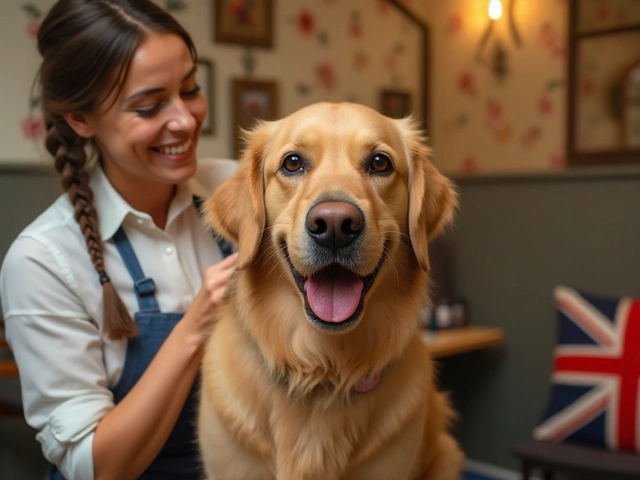Pet insurance is a vital consideration for anyone who owns a furry, feathered, or even scaly companion. With a range of animals and breeds to choose from, it's important to know why some pets might cost more to insure than others. Whether you're a first-time pet owner or a seasoned animal enthusiast, understanding the nuances of pet insurance can help you make informed decisions about your pet's healthcare.
While some pets generally come with lower insurance costs, others, especially certain breeds or exotic animals, can result in higher premiums. These costs are often influenced by factors like predisposed health conditions, the potential need for emergency care, and the life expectancy of the pet. By exploring these elements further, we can gain a clear picture of why pet insurance may be a significant part of owning certain animals.
- Factors Influencing Pet Insurance Costs
- High-Cost Dog Breeds to Insure
- Expensive Cat Breeds and Exotic Animals
- Tips for Reducing Pet Insurance Premiums
Factors Influencing Pet Insurance Costs
When considering pet insurance costs, it's essential to delve into a variety of factors that can cause prices to soar or settle. One of the main elements impacting the cost is the breed of your pet. Certain dog breeds, like Bulldogs or Rottweilers, are notoriously prone to specific health issues, driving up the premium costs. Cats too, such as the charming Maine Coon, may face genetic predispositions that elevate insurance fees. It's not just about the likelihood of illness, but also the potential expense of treatment for breed-specific ailments.
Age is another critical determinant in the pet insurance landscape. Younger pets tend to have less expensive premiums simply because they're less prone to some of the chronic conditions that manifest as they grow older. However, as pets age, the likelihood of developing conditions like arthritis, diabetes, or kidney disease increases, which naturally reflects in the insurance policy pricing. For first-time pet owners, this may come as a surprise, but speaking with current pet owners would reveal how these costs can certainly add up over the years.
"The average annual premium for insuring a senior pet can be twice as high as that of a younger animal," notes a popular pet insurer.
Location plays a surprisingly influential role in determining how much you'll pay for pet insurance. The cost of veterinary services is not uniform, varying greatly by region. Urban areas often have higher veterinary fees compared to rural ones due to the broader access to specialized care and facilities. It means pet owners in cities like Bristol can expect to pay more not just for care, but for the insurance that covers it.
Lastly, the type of coverage you choose significantly impacts the final premium. Comprehensive policies covering accidents, illnesses, and even wellness visits will naturally cost more than basic accident-only plans. The choice of deductibles, co-pays, and maximum payouts can also sway the cost. Pet owners may feel overwhelmed by these choices, but a detailed discussion with an insurance agent can illuminate the best path based on personal preferences and financial capacity.
For a deeper understanding, it's helpful to consider an example. Let's take the costs of insuring exotic pets, which can be much higher because they often require specialized veterinary care. If we examine a
| Pet Type | Average Annual Premium |
|---|---|
| Reptile | £500 |
| Bird | £450 |
| Rabbit | £350 |

High-Cost Dog Breeds to Insure
When it comes to pet insurance costs, not all dogs are created equal. Certain breeds come with their unique set of challenges, which often translates into higher insurance premiums. Understanding the reasons behind these higher costs is crucial for pet owners who wish to keep their pets healthy without breaking the bank. Among these expensive breeds to insure, you'll find both large and small dogs, each with its characteristics and common health concerns that drive up expenses.
One of the key factors contributing to high insurance costs for specific dog breeds is their predisposition to genetic diseases. Breeds like the English Bulldog and French Bulldog are notorious for their respiratory issues due to their brachycephalic nature. As a result, owners may face frequent vet visits and specialized care, both of which add up quickly. Similarly, larger breeds like the Bernese Mountain Dog and Great Dane often suffer from joint problems like hip dysplasia, requiring costly treatments and surgeries to manage their pain and mobility.
Additionally, some breeds have a shorter average lifespan or are prone to certain cancers, such as the Boxer. Their higher likelihood of developing serious conditions means insurers anticipate increased claims, which they balance out by demanding higher premiums. In a detailed study by the American Kennel Club, it was found that Boxers have a high risk for lymphoma and other malignancies. Hence, ambitious Boxer owners should be prepared for higher insurance costs. On the contrary, a smaller breed like the Cavalier King Charles Spaniel can develop heart issues at a young age, presenting challenges that inflate insurance rates significantly.
Aside from health concerns, behavior can also impact insurance rates. Breeds considered more aggressive or prone to causing accidents, such as Rottweilers or German Shepherds, often face higher premiums. Insurers factor in the potential for these dogs to require legal representation in liability cases or emergency animal control intervention. A well-respected pet insurance analyst once mentioned, "Owning a pet that insurers perceive as high-risk may result in higher premiums or limited policy coverage," highlighting the importance of understanding breed-related risks ahead of time.
For those determined to own these breeds despite the potential expensive pet insurance, there are ways to manage costs. Opting for higher deductibles on policies can reduce monthly premiums while ensuring that significant medical events are still covered. Some insurers offer preventative care packages, which can help mitigate the long-term expenses associated with known breed-specific issues. Moreover, engaging in regular health checkups and adopting a healthy lifestyle for your dog can also play a substantial role in reducing the frequency of insurance claims.

Expensive Cat Breeds and Exotic Animals
Diving into the fascinating world of cat breeds, it's astonishing to see how insurance costs can vary so widely among them. Take the beloved Bengal cat, for example. This breed, admired for its exotic markings and energetic personality, often finds itself high on the list when it comes to insurance premiums. Bengals are known for being quite active, which can sometimes lead to injuries that increase the cost to insure them. Additionally, they may have a predisposition to certain hereditary conditions, putting them in the spotlight for insurers who anticipate higher medical expenses over their lifetime.
Another example is the Sphynx, a breed most people recognize due to its hairless appearance. While they might seem like low-maintenance pets, Sphynx cats are prone to skin issues and require regular vet visits to manage their unique needs. These factors can drive up insurance costs as pet owners try to ensure their feline friends live healthy and trouble-free lives. Let's not overlook the Maine Coon, a gentle giant known for its significant size and friendly nature. Maine Coons tend to suffer from heart conditions such as hypertrophic cardiomyopathy, which demands ongoing monitoring and treatment—again, a reason why their insurance might inch higher than average.
Moving beyond our feline friends, there's a whole exotic world that brings its share of insurance complexities. Owners of exotic pets, like reptiles and birds, often face high insurance bills due to the specialized care these creatures demand. Reptiles such as iguanas or snakes may require specialized environments, precise dietary needs, and occasional veterinary care from an expert in exotic animals. Birds, particularly larger species like parrots, are known for their long life spans, which can lead to increased veterinary bills over the years. It's crucial to remember that these adaptable creatures often resonate with particular traits that could lead to insurance companies adjusting premiums accordingly.
For those starry-eyed about owning a unique, exotic animal, it's worth noting the considerable investment not only in terms of purchase price but also ongoing care, including insurance. A useful tip when considering an exotic pet is to research the specific care needs and potential health concerns in advance. According to a study by the National Exotic Pet Insurance Database, dedicated to understanding insurance in this niche, "Specialized veterinary care for exotic animals often incurs a premium due to the expertise required." This emphasis on expertise underscores why such pets can have higher insurance costs compared to more common domesticated animals.
To aid pet owners, some insurance providers offer tailored plans for certain exotic species, allowing for a more catered approach to their unique requirements. Always take the time to explore different insurance options and understand what’s included—emergency surgeries, routine check-ups, and medications. It's beneficial to compare various insurance plans, possibly enlisting help from forums and communities where fellow exotic pet owners share experiences. Tracking down a policy that aligns with the specific needs of your exotic pet ensures they're well-covered without any surprise expenses that could hurt your wallet.

Tips for Reducing Pet Insurance Premiums
Owning a pet can be a rewarding experience, but it comes with its financial responsibilities, including pet insurance costs. These expenses can sometimes weigh heavily on a pet owner's budget. However, there are strategic ways to cut down on these premiums while still ensuring that your beloved animal gets the proper coverage. Let's explore some practical tips that could save you money and help with managing your pet's healthcare finances effectively.
Firstly, consider the breed and type of pet you own when choosing an insurance plan. Some high-cost dog breeds to insure or even certain cat breeds come with inherent health risks that can elevate premiums. If you're yet to acquire a pet, research breeds that are traditionally known for lower insurance costs, as they exhibit fewer genetic health problems. If you're already a pet owner, tailor your policy to meet their specific health needs. A cat or a dog from a breed known for longevity and robust health will generally incur lower premium costs.
Next, one of the more effective strategies is to shop around and compare different insurance providers. Each company has its own system of evaluating risk and setting pet insurance costs. Securing multiple quotes allows you to evaluate what aligns best with your expectations and budget. Many people overlook the nuances between providers, often seeking portfolios with the most extensive coverage without considering unutilized services. It might be helpful to read customer reviews or seek recommendations from veterinary professionals who have a sense of which insurers offer support when it’s truly needed.
"Many owners find themselves paying for coverage they don't need," says James Sanders, a pet insurance analyst at PetWise UK. "Understanding your pet’s lifestyle can eliminate excess charges."
Additionally, there's the option to adjust your deductible— the amount you pay out-of-pocket before your insurance kicks in. By opting for a higher deductible, you can reduce your monthly premium significantly. Ensure that the deductible aligns with what you can comfortably manage in case of a sudden medical bill. It's a balance that requires careful attention to your finances and your pet’s potential health risks, acknowledging that unexpected medical situations require readiness.
Some providers also offer discounts if you insure multiple pets under the same plan. If you own several animals, this might be an effective way to minimize costs. Look for loyalty discounts or offers for long-term plan commitments, which can provide lower rates. Staying with a particular provider over time might prove beneficial, given they often reward customer loyalty with reduced premiums.
| Strategy | Potential Savings |
|---|---|
| Increase Deductible | 10-20% Reduction |
| Multi-Pet Discount | 5-15% Reduction |
| Long-Term Plans | 5-12% Reduction |
Remember, maintaining a healthy lifestyle for your pet can directly affect insurance costs. Regular check-ups, a balanced diet, and appropriate exercise routines not only keep your pet healthy but can also see reductions in premiums due to a lower risk of disease. Insurance companies might offer reductions for annual wellness check-ups, which promote proactive health management.
Ultimately, reducing pet insurance costs involves a mix of smart planning, understanding of your pet's health needs, and diligent research into available insurance options. Approaching your pet’s insurance strategically ensures both healthier pets and more mindful financial planning.







